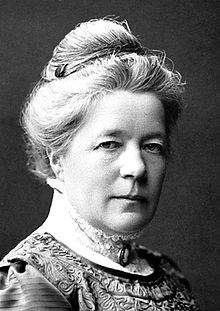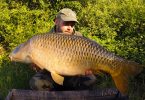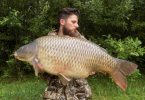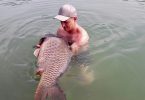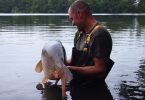As our boat sped past Ӧstra Ämtervik on Lake Fryken in Sweden on a warm July afternoon, about the only thing on my mind was catching a Swedish record pike. The home of Selma Lagerlӧf, the first female winner of the Nobel Prize in Literature in 1909, passed by on the eastern shore without so much as a spare thought. This trip was not about literature or history but the simple joy of fishing for big pike and maybe even a record.
Lagerlӧf wrote the novel Gӧsta Berlings Saga (The Story of Gӧsta Berling) in 1891 which has since been published in over 50 languages. The story is set in the 1820s and transpires along Lake Fryken (referred to as “Lӧvens Lȧnga Sjӧ” in the book). Her romanticised descriptions of the lake soon caught the attention of the literate population of Europe, bringing scores of tourists to Lake Fryken for the first time.

Selma Lagerlӧf, ca. 1909
Just two weeks before my trip, a 20 year old Swedish angler caught a pike on the same lake purportedly weighing in at 43 lb. 10.4 oz, destroying the prior Swedish record of 42 lb. 10.2 oz. He made the mistake of posting a photo of himself and the fish on Facebook and within a day it had gone viral, with more than 8000 “likes” – such is the popularity of pike fishing in Scandinavia and the rest of the world.
A reporter from the local Swedish newspaper NWT had soon written an article describing the catch and the race to fish Lake Fryken for big pike was underway, especially since the Swedish anglers had the benevolence to release the fish back into the lake just outside of Kolsnäs where it had been caught. This just happened to be where my professional fishing friend Anders Bladh and I were heading to start an all-night fishing expedition. As it happens, Kolsnäs is situated just in front of the Selma Lagerlӧf Hotel, named in honour of the Nobel Laureate, in Sunne, Sweden.
Lake Fryken
Nowhere is the 80 km (50 mile) long Lake Fryken described more beautifully than in the first chapter of Lagerlӧf’s novel The Story of Gӧsta Berling. The description of the mist-covered lake and surrounding landscape was so enticing that turn of the century tourists flocked to Lake Fryken to marvel at its beauty and take a ride on one of the many steamboats ferrying people and goods up and down its shores.
The lake is renown to be cold and deep, so deep that when the steamboat Freja sank in 1897 at the cost of 11 lives, 79 years passed before the wreck was located in 1976 and a further 18 years passed before Freja was raised from the depths in 1994. Happily, Freja was re-launched on 23 July 1997, exactly 101 years from the date it sunk beneath the waves, and is the only steamboat still making the rounds on Lake Fryken.
Lake Fryken usually runs at a depth of 90 to 95 metres in its middle portion, known as Middle Fryken, but reaches as deep as 130 metres (appox. 425 feet) in places. The current of the lake generally flows southward as the water runs out of the long valley from the north, eventually dumping into Lake Vänern, Europe’s third largest lake, via a connecting river located in Lower Fryken, the southern-most portion of the lake. Oddly, the water temperature can be higher in the northern sections than the south. This was the case on the day as the temperature ranged from 16.8 C in the south to 17.2 C at the top of Middle Fryken. In any event, those are ideal temperatures for good pike fishing.
Kolnäs, where the Swedish record pike was caught, is a small peninsula located at the top of Middle Fryken, where the deep water mingles with the shallows and creates an ideal transition zone for big pike. Further to the south, is Malӧn, the only Island on Middle Fryken. It is situated just off the shore and marks an area that has also consistently produced large pike.

Malӧn in the distance at Sunset
The island is notorious as an old Viking gravesite and rumours have it that those executed and then buried there still haunt it to this day. When I heard the story, I was glad I was in a boat safely offshore. We concentrated on the area between Kolnäs and the 90 metre deep waters to the east of Malӧn.
Pike Fishing Records
Record pike are so big that you can have a hard time comprehending their size compared to a normal representative of the species Esox Lucius, also known as Northern Pike or simply Northern in the United States and Gädda in Swedish.
The official world record pike recognized by the International Game Fishing Association is a 55 lb. 1 oz. monster caught on Greffen Lake in 1986 in what was then West Germany. Other uncertified pike records exist throughout the world with weights exceeding 60 lbs.

Reigning king of the monster pike
Although numerous contested reports exist from the turn of the century regarding giant pike caught in Ireland and the U.K., the official U.K. record still stands at 46 lb. 13 oz. caught in 1992 at Llandegfedd Reservoir in Wales – a genuine monster in its own right.
The Swedish Record
As reported by NWT, the story of the new Swedish pike record was a gripping duel between men and fish. I say “men” because the huge pike managed to hit two of the three lures dragging behind a small boat powered by a 5 horsepower motor. This meant that the fish was battling two anglers at the same time. The Swedish anglers were speechless in the 25 minute fight that ensued, struggling not to tangle their lines and to work together to take on the enormous power of the pike.
Once they landed the monster pike, they measured and weighed it and even took a photo of it that, as noted, appeared on Facebook and then in the NWT article. Unfortunately, they took the photo with an oar run through the gills, a display tactic that catch and release fishermen were understandably upset about.
For the record, if you strive to be a good catch and release fisherman and are dealing with large pike, you should try your best not to damage the gill rakers (the red slits within the gills) by using forceps to remove the lure and displaying the fish in a manner that doesn’t damage them. Big pike can survive a great deal of damage to their mouths but damage to the gill rakers is difficult for even the hardiest of pike to overcome.
The authenticity of the weight and length of the pike is still being debated. A number of local anglers have noted that it was a tremendously large pike but lacked the girth to have exceeded the old Swedish record. It remains to be seen whether the catch will be recognized as the new official record.
Fishing Equipment
On the day, we were fishing with 8 graphite rods trailing our boat and a plethora of lures of varying depth and complexity. Anders had made the switch to graphite from fiberglass over the past year due to the rod’s responsiveness and lighter weight and despite the criticism that graphite rods may have less strength.

8 graphite rods on the way to Middle Fryken
The Swedish record was caught on a wobbler, which most likely was a jointed plug with two or more treble hooks. Anders is nothing less than an aficionado when it comes to lures. We had four crates of lures of varying sizes and colours, each with its own unique characteristics.

One of the crates of pike and zander lures
The lures we used were predominantly plugs (also known as “wobbler”) varying in length, colour, rattle and the type of vein (the plastic or metal plate that extends from the front of the lure). The most popular colours were a combination of green, yellow and orange but red also featured as well as a blue mackerel colour (reserved for pike rather than zander fishing). Some of the lures were even hand painted. The length of the lures varied from ca. 5 to 8 inches.
The size and angle of the vein is important in order to cover a range of depths across the 8 rods in action at any time. Longer, flatter veins push the lure deeper. Small more angled veins cause the lure to run closer to the surface. By carefully choosing the veins, a variety of depths can be tested at one time, with subsequent adjustments based upon the success of a particular depth on the day.
Armed with our eight graphite rods and assortment of lures, we settled in for a night of fishing for monster pike comforted by the knowledge that we had at least a few numerical advantages over the Swedish anglers who had caught the record pike.
Evening Fishing
By 6:00 pm, all 8 rods were in action. We put side-boards out on either side of the boat and ran four relatively even-spaced lines out on each side at varying depths. With the motor down to a crawl for the first time, all that was left was to point the boat in the direction of Kolsnäs and to wait for one of the clips to fly off the line fastened to the side boards.
By 6:45 pm we had our first strike. Pike fight furiously until they have no strength left and this one was no exception. Even though our first catch was only just over 70 centimeters (27.5 inches), I already had a sense of the battles that would come over the rest of the night and early morning. For the record, the slot limit on the lake is 50 centimetres (ca. 19.7 inches) but we caught and released all the pike in any event.
The evening hours were filled with some big strikes and some big Pike but sadly a few too many that never made it into the boat. One strike not far from Kolsnäs was so hard that I couldn’t budge the fish without the drag spinning the line out for some time. That was only a few moments before I felt the line suddenly slacken and knew I had lost a monster.
Our last big pike of the evening was caught just before 11:00 pm as the sky clouded over bringing an early end to the light that can last much longer in the northern climate during June and July. The fish fought well but was no match for the graphite rods and quality reels, despite the tired fisherman operating them. We ended the evening having caught and released 5 large Pike ranging between 70 and 88 centimetres (27.5 to 34.6 inches). Not a bad evening in any fisherman’s log.

One last evening pike
Maybe it is just me but as the clock starts to approach midnight, the thought of going home and nestling under a warm blanket in bed seems rather appealing no matter what sort of fishing or other excursion is on at the time. The appeal of the warm-blanket option was bolstered by the wind and rain setting in and also the knowledge that pike generally will not feed when there is little or no light.
Nonetheless, when you fish Lake Fryken with a dedicated professional such as Anders, you would never let the words “maybe we should call it a day” slip from your lips no matter how cold you were or how great the temptation might be. To do so would risk your reputation as a fisherman for countless years to come. As the cold damp set in, the only option for staying warm was mildly disguised isometric exercises, tensing and relaxing various muscles while trying not to visibly grimace or shiver.
As the last of the light faded, we slowed down the motor to a speed of 1.9 to 2.2 knots, rather than the 2.1 to 2.5 knots we had used during the sunlit hours. This is simply a technique to favour zander (known as Gӧs in Swedish and Sander Lucioperca in Latin). Zander have better night vision than pike and are accordingly more nocturnal. The colours of the lures used also changed, taking away the darker mackerel blues used to attract pike in favour of lighter shades of green, yellow and orange that are more attractive to zander. [Authors Note: we landed a 10 lb. 7 oz. zander the next week using this technique.]
Early Morning Strikes
If it has never happened to you, falling asleep on your feet is a jolting experience. In an instant, your knees buckle and you are forced to recover quickly before landing on the floor. I managed to fall asleep on my feet twice in the early morning hours without hitting the deck as the rain drizzled and the winds died down. Eventually, your mind slows to a snail’s pace as the hum of the motor lulls you into a near catatonic state.
This all changed at 3:40 am when the biggest fish of our trip took advantage of the first light to try to eat an early breakfast. The sound of the line snapping off the clip from the force of the strike was loud enough to spur us into action even before seeing the rod bow down under the strength of the fish. Anders took the rod and worked the fish hard, relying on the drag of the reel to sap the big fish of its strength.
You never know for certain on Lake Fryken (or elsewhere for that matter) whether you are into a big pike or a zander until you first see the fish. Zander provide one of the best tasting fresh water fish on offer and are much prized by anglers and people who love fresh-water fish and eating in general.

Early morning visitor at 3:40 am
As the fish neared the boat we saw that it was a good sized pike and landed it in the net. Once in the boat, we measured the pike at just over 90 centimetres (37.4 inches) and weighing more than 12 lbs. The last big pike was caught at 6:40 am, another good sized fish.

One last strike just east of Selma’s Mȧrbacka
In the end, we caught and successfully released 8 big pike off of 13 strikes, ranging between 5 and 12 pounds and 70 and 90 centimeters (27.5 to 37.4 inches). Just after 7:30 am we decided to bring in the lines and head for the small boat harbor at the southern point of Lake Fryken.
We never did manage to catch the record pike we had hoped for but had a very satisfying 15 hours on the lake and caught a number of good sized pike. For me though, great fishing experiences are not defined by their ultimate success but rather by the challenges you are up against and the simple joy of the pursuit itself. The fact that we were able to pursue monster pike in the shadow of a Nobel laureate, that had so enchantingly described Lake Fryken itself, made the experience that much more satisfying.
By Scott Cameron©
Photos: Anders Bladh and Scott Cameron. Certain historical photos have been taken from publicly available sources.













